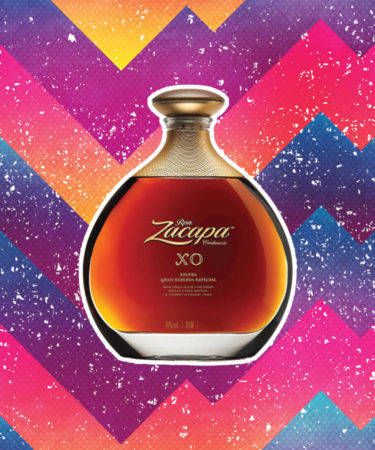
Arguably the most important thing to know about rum this time of year is that it’s in your glass. And while we too plan on pursuing carefree rum consumption this season, while also quietly praying that “moisture wicking technology” is actually a thing, we like getting a bit better acquainted with our favorite spirits: tequila, yes, please, gin, why not?, and, most definitely, rum.
Also known as “rhum.” Or “ron,” as in Ron Zacapa. With a complex, literally sky-high aging process, a take-no-prisoners genius master distiller, and a reasonable claim to flavor descriptors like warming vanilla and delicate spice, Ron Zacapa’s got more than a few points of interest to lubricate your cocktail party (or porch swing) conversations.
Here are nine things you need to know about Ron Zacapa.
It was developed by a doctor, so it’s good for you.
Yeah, kidding. It’s still rum. But Ron Zacapa was in fact developed by a chemist. Local Guatemalan doctor Alejandro Burgaleta tinkered with the distillation and stabilization of his rum for some time before finally unveiling the first bottle of Ron Zacapa Centenario in 1976, on the centennial anniversary of the town of Zacapa in eastern Guatemala. The rum quickly became one of the country’s marquee products, a source of pride in terroir and technology, ideally enjoyed in moderation. So yes, a far cry from the days when dreamy-eyed fake physicians suggested you “give your throat a vacation” and “smoke a fresh cigarette.”
Ron Zacapa’s (female) master distiller is a force of nature.
Master distiller Lorena Vásquez is a force to be reckoned with. A Nicaraguan transplant, Vásquez has a background in pharmaceutical chemistry and found her way to booze via beer. She built her three-decade career on a backbone of technical expertise, but her soul is rum — she relies most importantly on a profound trust of her own palate, which is meticulous, persnickety, and generally absolutely correct.
You should keep the hand-woven ring on the bottle.
A lot of bottle swag is exactly that — swag, the final touches of branding. In other words, bizarro decoration from a marketing team groping at authenticity with kitschy regional signifiers. But the woven rings on Ron Zacapa 23 are the real thing. Another of Lorena Vásquez’s passion projects to showcase and financially empower local communities, the rings are made from dried palm leaves and hand-woven by local indigenous women in the petate-style of the Guatemalan Maya.
The distillery developed a hybrid machete.
This means two things. Firstly, that the sugar cane used to make Ron Zacapa rum is actually harvested by hand, which leads to a smarter yield at greater discretion of the harvester (as opposed to mechanized efficiency that also can’t selectively recognize perfect ripeness). Additionally, the company is so committed to efficiency and quality that it developed a custom tool to harvest sugar cane at its freshest. And said tool is a hybrid machete. A hybrid machete.
It is special from the very start.
Most rum is distilled from molasses, with yeast feasting on those darker caramelized sugars. Ron Zacapa is distilled from something called “virgin sugar cane honey,” or “virgin honey,” the syrup that comes from the first pressing of the cane plant, with about 72 percent sugar content, compared to molasses’ approximate 50 percent. Combine that with the gentler aging process (see “Star Wars” below), and you start to see where the aspirational finesse of the Ron Z flavor profile comes from.
It has something in common with “Star Wars.”
Most of the action — and (spoiler alert) betrayal — of “The Empire Strikes Back” takes place in Cloud City. Most of the action in Ron Zacapa’s rum aging takes place in “the House Above the Clouds,” the nickname given to the aging facility 2,300 meters (about 1.4 miles) above sea level. The spot was carefully chosen by Vásquez herself for its cooler night temperatures and thinner, lower-oxygen air — better for a gentler aging process. (If you’re not afraid of secondhand heights, here’s 12 seconds of someone flying over the facility.)
It actually ages well.
There are bottles of the 15 year old out there, but the marquee Ron Zacapa is easily its 23 year, an age that seems geriatric for a “starter” bottle (and like lost youth for the rest of us). Because it’s aged at such elevation, the aging process itself is a lot gentler —consistent cooler temperatures and lower atmospheric pressure ease the natural molecular exchange between spirit and barrel. We compare it to spending your 30s in a quiet spa versus in an over-sugared kindergarten classroom that just banned naptime.
The rum is 23, but also 6.
Like sherry, Zacapa is aged by “solera.” In this complex, carefully monitored but also highly intuitive process, a spirit, wine, or vinegar is aged in a succession of stacked barrels, the oldest typically on the bottom. Rum as young as six years old ends up combined with much, much older rums, the goal being a flavor profile that consistently blends age and barrel expression. (Additional fun fact: Zacapa ages its rum in whiskey, Pedro Ximenez, Cognac, and French oak barrels, all chosen by globe-trotting master distiller Vásquez, who clearly has the best job ever.)
The company wants to chuck your Rum and Coke.
Rum and Coke is a fine summer drink. But considering aforementioned air-traffic-control-level altitude, tedious-but-loving Solera process, 23 years to profit, and so forth, maybe it’s no surprise Ron Zacapa isn’t exactly psyched if the first thing you do after buying a bottle of its rum is douse it with “the Real Thing.” (Plus that way you can save your Coke for that bottle of Fernet.) Seriously, Vásquez herself recommends you try it neat first, especially if you’re starting with the 23 year. Summer will immediately feel less sweaty and more sexy. Well, probably still just as sweaty. But now also sexy.
